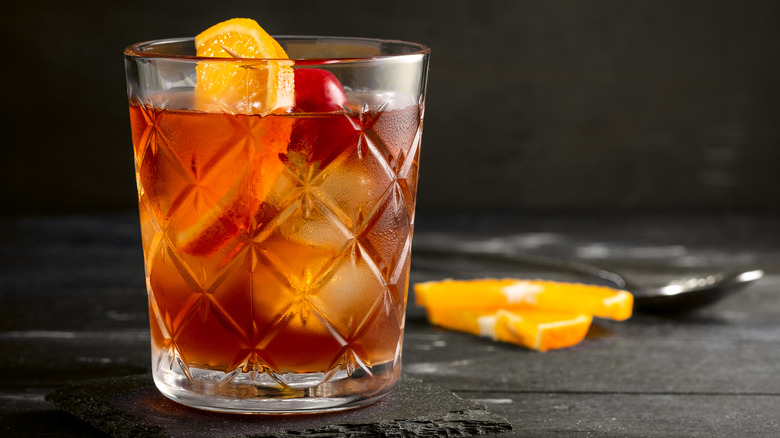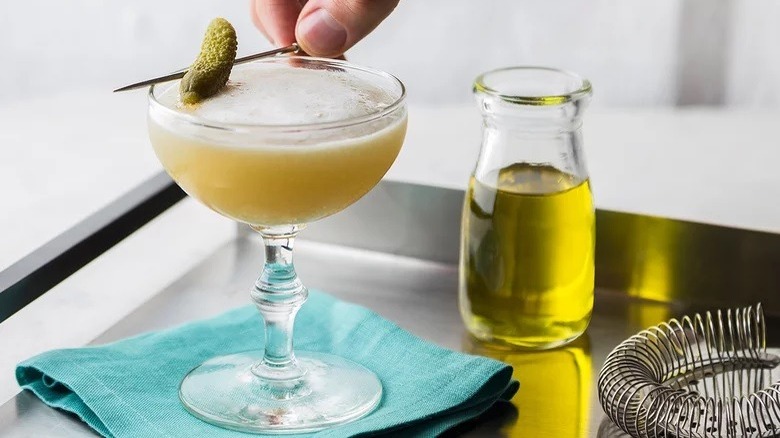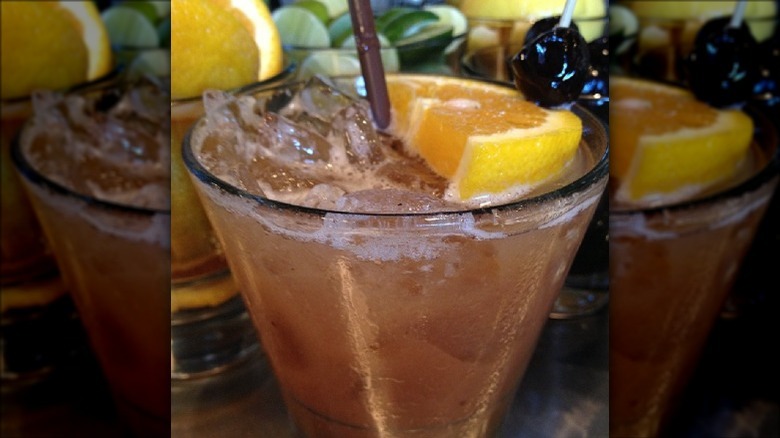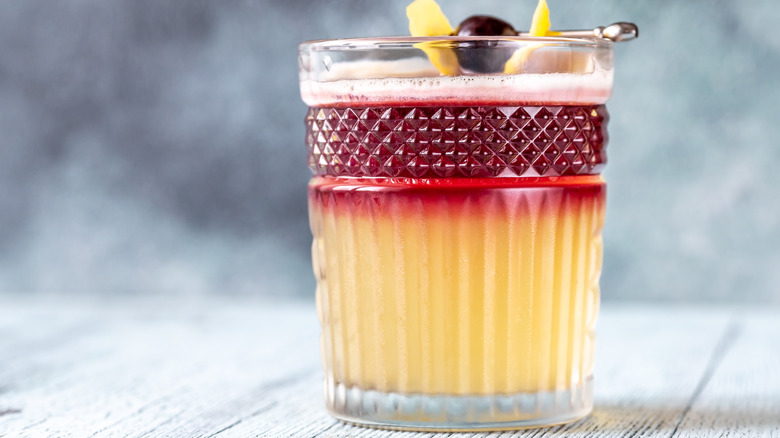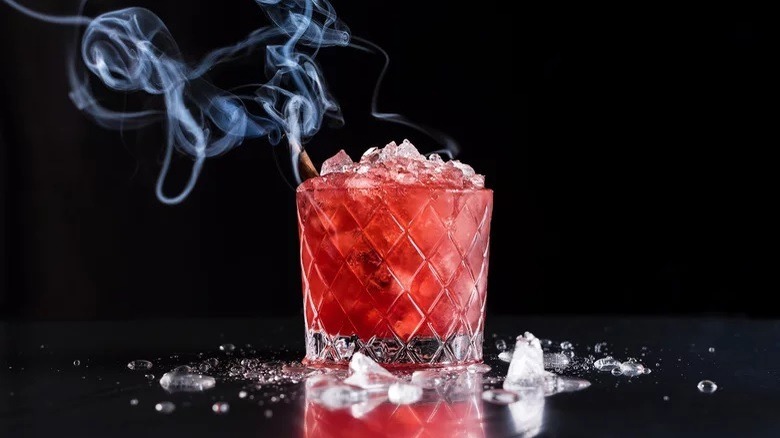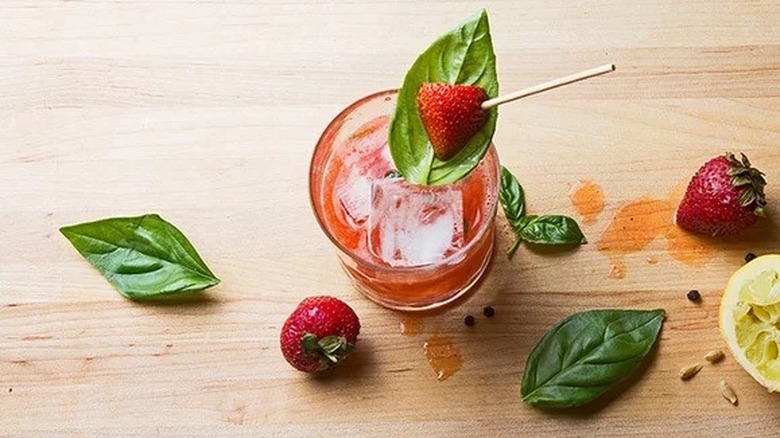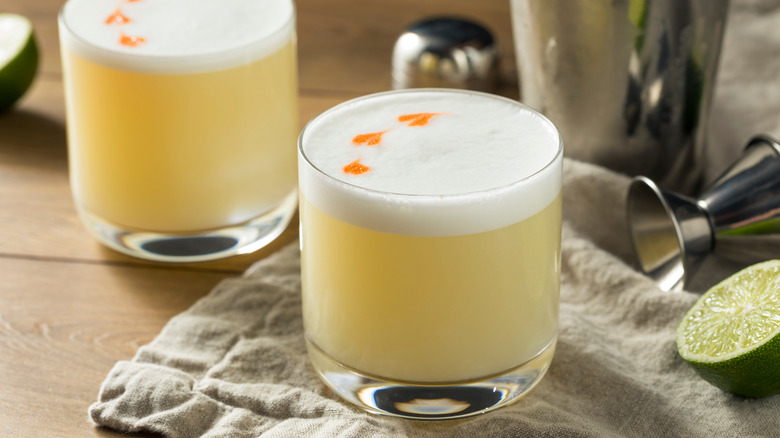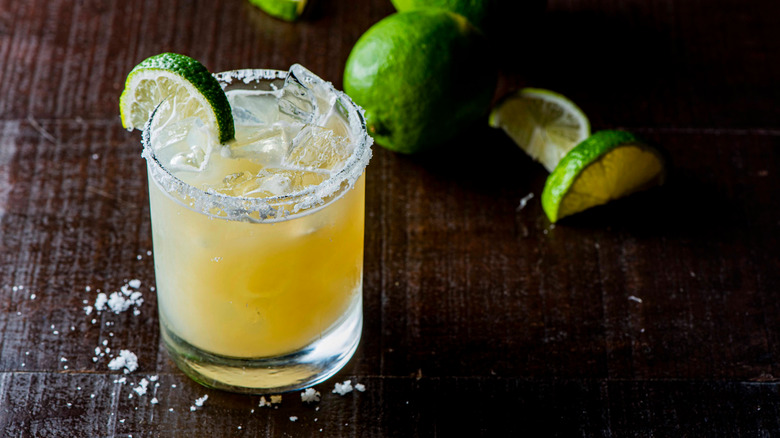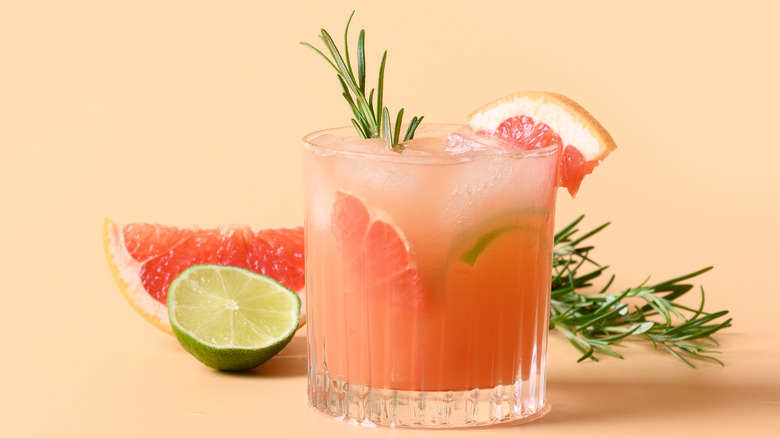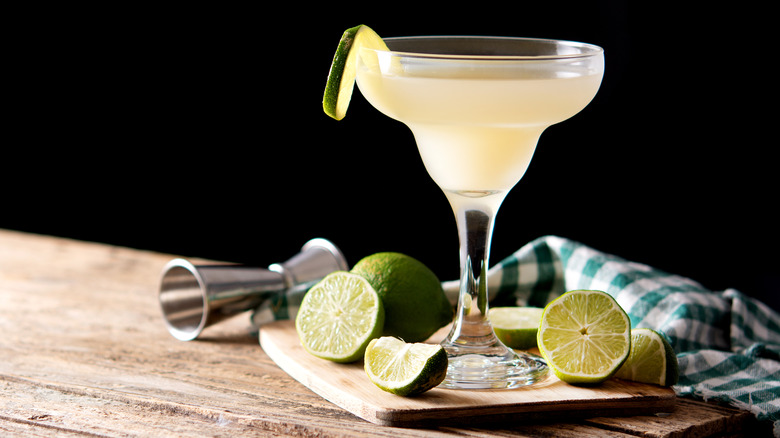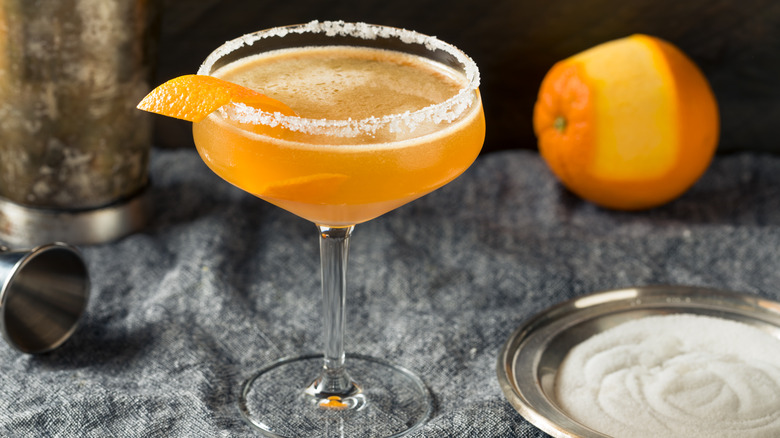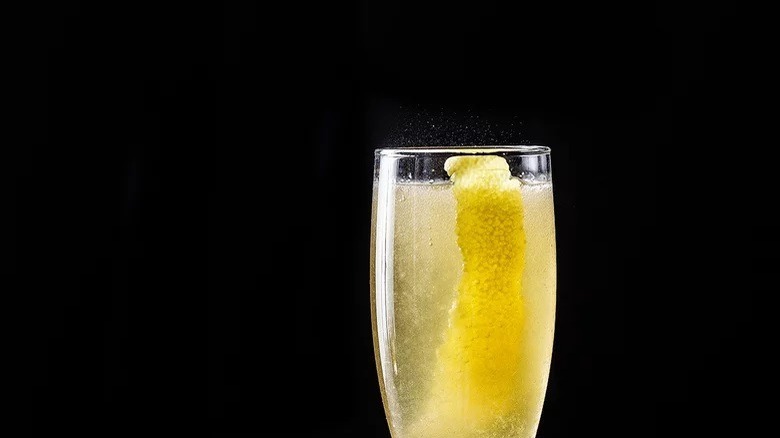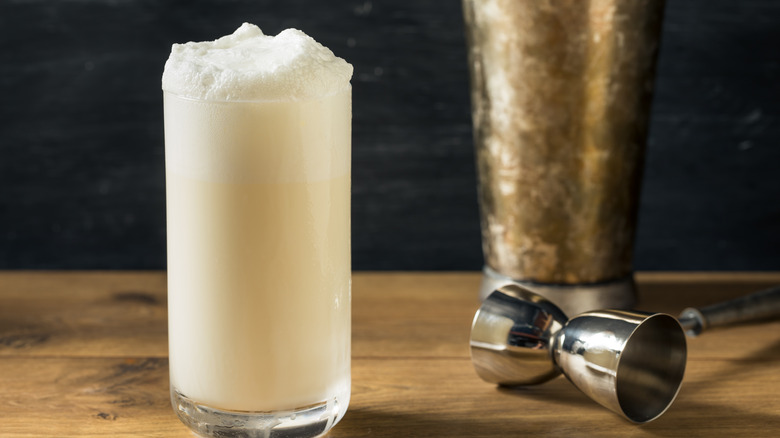12 Cocktails To Try If You Like Whiskey Sours
When it comes to crafting cocktails, don't be afraid to stick with the basics. Sure, the era of modernist mixologists whipping up complicated boozy beverages using multiple obscure ingredients and fancy doodads continues to flourish — and that's all fine and dandy. But the simple standards are classics for a reason.
Take the humble whiskey sour, for example. With just three ingredients — bourbon or rye, freshly squeezed lemon juice, and simple syrup (plus the orange and cherry garnish) — the interplay of sweet and tart from the sugar and citrus components works harmoniously with the caramel, oak, vanilla, and peppery spice imparted by the beverage's base brown spirit. Easy enough to make at home, and the beverage of choice for many bar patrons, a whiskey sour never disappoints (assuming the drink isn't sullied by the addition of a cheap, inferior pre-made mix).
That said, sometimes a little change can do you good. That's why we've rounded up a list of cocktail alternatives to the whiskey sour. While each of these options offers a distinctive variation on the classic drink, they all find a way to connect to the spirit of the holy trinity of bourbon (or rye!), lemon, and sugar.
Pickle Sour
Whether they're used as a condiment or a snack, pickles (specifically, the cucumber variety) can be polarizing under normal circumstances. It hits the sweet spot for some, while others cast off the fermented veggie as being way too tart. While the pickleback — a shot of whiskey with a pickle juice chaser — has made its way into mainstream bar culture, actually adding the briny liquid directly into a cocktail might be a bridge too far, even for pickle fans.
But if you can't get enough of those herbed, spiced, vinegar-y, salty cukes (and/or if you prefer your martinis on the dirty side), then give the Pickle Juice Whiskey Sour a try. Frothy egg whites are what takes this cocktail to the next level, not only adding visual appeal but providing a smooth, creamy counterbalance to the sour and savory pungency of the pickle juice and bourbon spice. Then, finish with a garnish of cornichon (those teensy weensy wrinkly pickles) to serve as either an enticement or a warning to the person you're serving, depending on their pickle preference.
Tamarind Whiskey Sour
It would be a rather difficult undertaking to replicate Chef Andy Rickers' faithful, and often highly complex renditions of traditional Thai fare. Thankfully, one of Ricker's most popular cocktails is a bit more achievable for the home chef/mixologist.
The key ingredient, beyond the bourbon, in Ricker's Tamarind Whiskey Sour is concentrate from the namesake mouth-puckering fruit, though if you can get your hands on some real deal pulp, that will work too. While tamarind can be traced back to Equatorial Africa, it has become a staple in cuisines around the world, including Thailand where it is used to add a sour dimension to a number of dishes including pad Thai. Thus, it's no surprise that Ricker chose to add it to his boozy repertoire, which he told Tasting Table, "was the very first cocktail that I came up with for Pok Pok," his highly acclaimed Thai restaurant mini-chain. Beyond the tamarind, lime juice comes into play to contribute to the tartness, while palm sugar simple syrup prevents the cocktail from being overly puckering.
New York Sour
Start spreading the news about this stunning cocktail with (possibly questionable) Big Apple roots. Per Wine Enthusiast, a New York Sour sticks with the core ingredients of your standard whiskey sour, combining 2 ounces of bourbon (or rye, if you prefer), 1 ounce of lemon juice, and ½ ounce simple syrup. Since this is a New York cocktail, it's no surprise that the beverage is taken to greater heights with the addition of a red wine floater. The 1 ½ ounces of vino provides some extra fruitiness, dryness, and not to mention, sumptuous visual flair. For added pop, you can even include an egg white topper.
As for the cocktail's origins, according to Liquor.com, it dates back to the late-19th century and was originally referred to as Continental Sour. There is also some speculation that the recipe was actually conceived in Chicago, not New York. Regardless of where it actually came from, the cocktail now falls squarely within an Empire State of mind.
Taking a cue from the world of sports, there is also a rival Boston version of the whiskey sour that skips the red wine and simply adds the layer of egg white.
Bourbon-Blackberry Cocktail
Blackberry is a natural addition to a whiskey sour, helping to amplify those sweet and tart notes while bringing a welcome bitter edge. This Bourbon-Blackberry Cocktail, courtesy of the celebrated Jack Rose Dining Saloon in Washington D.C., takes things beyond a simple fruit addition. The familiar whiskey sour combo of lemon juice and bourbon is present, but as for the signature spirit, you're just going to add 1 ¼ ounces to your rocks glass. That's because ¼ ounce of Bruto Americano, a bitter, citrusy domestic apertivo will be joining in the fun.
The blackberry component comes via preserves, so there is no need for planning a special trip to the farmers' market just to procure fresh berries. A heavy dash of bitters rounds out the cocktail while a charred cinnamon stick garnish helps to spice things up. Though there are several ingredients in the mix, the ideal preparation is stirred, not shaken.
Strawberry Peppercorn Smash
Both strawberry and basil come into peak season around the same time of year. Late spring for strawberries (hopefully you have some farm fresh varieties available locally), and basil thrives throughout the summer months, almost growing like a weed when the sun shines in just the right way. Combining the two ingredients instantly screams warm weather and good times. Add some bourbon to the equation, and you're really in business. Enter the Strawberry Peppercorn Smash.
You'll need a proper cocktail shaker and a muddler to execute this fruity, herbaceous, and subtly spicy concoction. You'll also need to make some simple syrup (equal parts water and sugar raised to a boil and then cooled off — simple, indeed) to add sweetness, along with lemon juice to bring some necessary tartness. Seeing the similarities to a whiskey sour, yet?
Plenty of ice is essential, and this recipe also begs for freshly cracked black peppercorn so you can truly feel the heat in case your summer weather isn't hot enough. As its name implies, this cocktail will be a smash at your next get-together.
Pisco Sour
If your bar isn't currently stocked with a bottle of pisco, that needs to be remedied immediately. The clear spirit is a type of brandy made from common wine that is run through a still. When people think of pisco, Peru is the nation that generally comes to mind with its production, though it should be noted that it is also extremely popular in Chile, where more liberties can be taken with the spirit.
Chile and Peru lay claim to being the source of the most famous pisco-based drink, the pisco sour (it is the national drink of both South American countries), though regardless of its point of origin, the Peruvian version is the more likely rendition to show up on a cocktail menu in the U.S.
While some whiskey sour variations may include an optional egg white, the frothy topping is an absolute must for an authentic Peruvian pisco sour. Our version also includes lemon juice, lime juice, simple syrup, and, of course, the signature spirit. All the ingredients are added to a cocktail shaker and the trick is to start with an aggressive dry-shake in order to emulsify the egg whites, then add ice for another round of shaking. Strain and pour into a chilled coupe, and finish with a few drops of bitters. The result is a tart, fruity, and creamy cocktail that is wonderfully refreshing. If you happen to be averse to raw egg in your beverages, seek out the Chilean pisco sour which skips the whites and adds ginger and powdered sugar.
Margarita
Margaritas are often reserved for Mexican eateries, poolside or beachfront refreshments, and chain restaurant happy hours, but there is no reason it shouldn't be part of your standard bar rotation.
At its core, the cocktail follows the same basic playbook as the whiskey sour: booze, citrus, and sugar. The classic margarita is prepared with 1 ½ ounces of tequila, ¾ ounce of freshly squeezed lime juice, ¾ ounce of Cointreau (or another brand of orange-flavored liqueur), and ¼ ounce of agave syrup or simple syrup. Serve on the rocks with an optional salt rim.
Of course you can also go the frozen route, or choose an alternative margarita recipe that takes advantage of added ingredients, a fruit swap, or perhaps both. For the record, we're certainly by no means margarita purists, and encourage you to explore all the fun, fruity, and occasionally frozen riffs that are out there. Where we do tend to draw the line is the use of margarita mixes which often contain unsavory ingredients and lack the eye-opening zing that only fresh lime juice is able to provide. If you're going to order a margarita, do yourself a favor and ask your server/bartender if it will be made from scratch or come from a plastic bottle — if it's the latter, consider ordering something else (perhaps another cocktail that happens to be on this list).
Paloma
If a round of margaritas feels too much like the same-old, same-old cocktail order, try switching things up with a paloma. Having simple syrup and citrus at its base, it's not a far cry from a whiskey sour. With an emphasis on grapefruit as tequila's tart companion (versus copious amounts of lime juice in a standard marg), a paloma is, like its Mexican cocktail cousin, delightfully mouth-puckering and refreshing. There's also plenty of wiggle room to experiment with garnishes, bitters, and other fancy flourishes. This Pink Grapefruit & Chamomile Paloma adds a rose-infused salt rim and chamomile syrup for an elevated twist on the cocktail.
You might also want to consider swapping the traditional base tequila with mezcal. The trendy spirit will add an intoxicating, smoky depth to your paloma. If you want to move things way further outside the box, it's hard to overlook The Confident Man. The Clooney of cocktails, it sticks with the grapefruit, but goes in a completely different direction than the paloma spirit base, tapping in an intriguing trifecta of vodka, St. Germain, and Aperol.
Daiquiri
Like the margarita, the daiquiri often gets lumped into the tacky, low end frozen cocktail category. While the classic Cuban-born beverage became a Stateside sensation in the 1940s, according to Jane Danger, formerly of New York City Cuban bar Cienfuegos, Prohibition led to its downfall. "[I]t took a long time to catch up after that," Danger told Tasting Table. "Once we had, it became all about convenience. The '60s and '70s introduced the soda gun and the sour mix, and drinks like the tequila sunrise. Convenience ruined a lot of drinks, like mojitos, margaritas, and more, and we're still trying to fix the damage."
To be clear, the original, refined version of the daiquiri belongs far, far away from a plastic, yard-long drinking vessel. Traditionally served in a coupe glass, the Ernest Hemmingway-approved cocktail consists of a mere three ingredients: rum, lime juice, and sugar. Easy, right? Well, if you ask the experts, they'll tell you otherwise. "The hardest drinks to make are the simplest," said Danger. "They really let the ingredients shine through, and it shows the strength of a good bartender to be able to balance them. If you want to test a bartender, order a daiquiri and see what you get."
The key is balance, and while you can play around with the ingredients to suit your tastes, it's hard to go wrong with a well-regarded light white rum — and be sure that your limes are top quality.
Sidecar
The Sidecar is one of those bar classics that may sound familiar though you might not know exactly what is in it. Similar to some of the cocktails that we've covered, the ingredients list is relatively limited. Taking a cue from the whiskey sour, lemon juice and sugar make the cut, though the latter isn't a component of the actual drink. You will get some sweetness and another layer of citrus from a 1 ounce addition of orange liqueur (Cointreau or curaçao tend to be the go-tos).
The highlighted spirit here is Cognac, the French brandy that was also the rage in the 18th and 19th century, then fell out of fashion due to production issues and Prohibition, but is now having a renaissance. It's combined with the orange liqueur and lemon juice, given a few flips in an ice-filled cocktail shaker, then poured into a chilled coupe. Now you may be wondering, "what about the sugar?" Don't worry, we didn't forget. Before serving your Sidecar, wet the rim of the glass and coat it with the sweet stuff. Next time you find yourself in one of those throwback speakeasy spots, tell your mustachioed, suspendered bartender that you'd like to order a Sidecar, and you won't be sorry.
American 25
For those seeking a more celebratory spin on a whiskey sour, start poppin' some bottles. While the American 25 is directly inspired by the gin and champagne-based French 75, it features the essential elements of a whiskey, or rather, whisky sour with the inclusion of lemon juice, simple syrup, and just a wee bit of peated Scotch (Laphroaig 10 Year is preferred). While apple brandy (ideally from a bottle that carries the American-made Laird's label) joins the fun, it's the 4-ounce topper of Champagne that is the star of the show, providing bubbles, a touch of dryness, and plenty of class.
The American 25 is an obvious choice for standard Champagne celebrations like New Year's Eve, Valentine's Day, anniversaries, and birthdays. And considering the U.S. of A connection to the cocktail, we urge you to upgrade your Independence Day refreshment from a keg of Bud Light to a giant punch bowl of this delicious cocktail. (Who needs apple pie when you've got apple brandy?)
Garnish with a lemon twist, serve in a champagne flute, and have your toast at the ready.
Ramos Gin Fizz
If you're looking for something a little sweeter but still on the sour spectrum, this creamy cocktail will scratch that itch. Unlike some of the overly cloying dessert cocktails you may have imbibed, the Ramos Gin Fizz is remarkably well-balanced.
The sour component is covered by the citrus duo of fresh lime juice and fresh lemon juice. That's shaken up (for at least 30 seconds) with gin, heavy cream, an egg white, simple syrup, and a teaspoon of orange flower water. The fizz comes courtesy of soda water which is combined with its cohorts in a Collins glass.
This is not the type of cocktail that you want to order at any old bar. For one, it's a fairly cumbersome drink to make, so if the joint happens to be busy, you may be met with an icy glare if you attempt to ask for one (and that's assuming they're stocked with all the ingredients). It also takes an experienced hand to master the art of achieving peak Ramos Gin Fizz frothiness, so if you're intrigued by the cocktail (which you absolutely should be), seek out spots that specifically list it on the menu. The Sazerac Bar at the Roosevelt Hotel in New Orleans (the birthplace of the beverage) is our preferred venue. You'll also find an excellent rendition at Las Vegas gin joint Juniper, located in the Park MGM.
